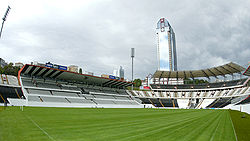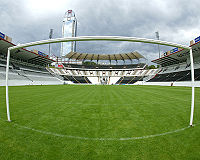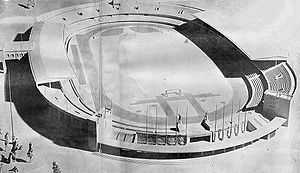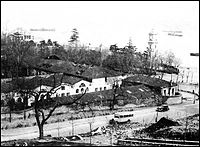- BJK İnönü Stadium
-
For other uses, see İnönü (disambiguation).
Fiyapı İnönü Stadium Kartal Yuvası (Eagle's Nest)
Loudest Stadium in the World[1]
Full name Beşiktaş İsmet İnönü Stadium Former names Dolmabahçe Stadium (1947-1952)
Mithatpaşa Stadium (1952-1973)
İnönü Stadium (1973-Present)Location Beşiktaş, İstanbul Broke ground 1939 Built 1947 Opened May 19, 1947 Renovated 2001-2002 Expanded 2002 Surface Grass Architect Paolo Vietti-Violi Capacity 32,145[2] Field dimensions 105 x 68 m Tenants Beşiktaş J.K.
Fiyapı İnönü Stadium (Turkish: Fiyapı İnönü Stadyumu) is a football stadium in Istanbul, Turkey and is the home ground of the football club Beşiktaş J.K.. Previously the ground has aso been shared with Galatasaray S.K. and Fenerbahce S.K.. The ground is located in Dolmabahçe, close to the Dolmabahçe Palace in the district of Beşiktaş, on the European side of Istanbul. The stadium has an all-seated capacity of 32,145.On October 24, 2007, during a Champions League match with Liverpool, İnönü Stadium took the title of "loudest stadium in the world" when the fans at the stadium reached a world record of 132 decibels.[1] This record was previously held by Liverpool fans.
Contents
Structure
Fiyapı İnönü Stadium has four stands: The Kapalı tribune which is parallel to the pitch at the north side can hold up to 5,881 supporters and it is regarded as the heart of the stadium, holding the most fanatical supporters.[citation needed] Facing the Kapalı is the Numaralı with a seating capacity of 5,237. The stands behind the goal areas are Eski Açık with a seating capacity of 7,962, and Yeni Açık with a seating capacity of 13,065. There are two towers on the left and right side of the Eski Açık stands.
The Bosphorus, Dolmabahçe Palace, Dolmabahçe Clock Tower, Dolmabahçe Mosque, and Kız Kulesi (Maiden's Tower) are viewable from within the stadium, and it is the only stadium in the world from which a football fan can view two continents, Europe and Asia, which are separated by the Bosphorus.[citation needed]
Before the stadium was all-seated the ground's capacity was over 45,000.[citation needed] İnönü Stadium holds the record for highest decibel level (132dB) ever recorded in football, in a match against Liverpool,[3] breaking the previous record which was held by the Liverpool fans in Anfield.
History
BJK İnönü Stadium was designed by Italian architect Paolo Vietti-Violi, who collaborated with Turkish architects Şinasi Şahingiray and Fazıl Aysu for preparing the project. The stable of the Dolmabahçe Palace was chosen as the location to build the stadium. The first foundation was laid on May 19, 1939, but the construction works were frozen due to the outbreak of the Second World War. The stadium was inaugurated on May 19, 1947, by İsmet İnönü, the second President of Turkey and himself a Beşiktaş fan, and Lütfi Kırdar, the Governor of Istanbul. The initial capacity was 16,000. In the original project plan, there were two bronze statues of athlete figures at the Eski Açık tribune: One throwing a discus, and the other one throwing a javelin. However, the statues were never built due to financial concerns. The oil factory which was found behind the stadium was demolished to construct the Yeni Açık tribune at the west part of the stadium in 1950 (hence the name Yeni Açık, meaning the New Uncovered tribune; referring to the two covered tribunes (Numaralı and Kapalı) and the two uncovered tribunes (Eski Açık and Yeni Açık).) Yeni Açık was also covered with a separate roof structure in 2004. Galatasaray S.K. and Fenerbahce S.K. have shared the stadium with Beşiktaş JK for many years, since the construction of the Ali Sami Yen Stadium, which is the home of Galatasaray football club, was completed in 1964. Şükrü Saracoğlu Stadium, the home of Fenerbahçe S.K., was renovated in 1982.
The first football match at the İnönü Stadium took place between Beşiktaş JK and AIK, Sweden, on November 27, 1947, and the first goal in the stadium was scored by Süleyman Seba; the most famous and longest-presiding Chairman of the club (in the 1980s and 1990s) when he used to be a player of Beşiktaş JK. Beşiktaş won this match 3–2. In 1952, the stadium was named as the Mithat Paşa Stadium, and later in 1973, it was renamed as the İnönü Stadium. A leasing contract was signed between Beşiktaş JK and the related ministry in February 1998 which gave all usage rights of the İnönü Stadium to Beşiktaş JK for 49 years.
Renovation work took place at the BJK İnönü Stadium in 2004. The tartan track was removed within the scope of these activities and the ground level was lowered by 4 meters to increase the capacity of the stadium to 32,145 spectators. The press seats were relocated to the Numaralı tribune from the Kapalı tribune. The lounges that were found in the middle of the Kapalı tribune were demolished and for the first time in Turkey, the wire fence between the tribunes and the pitch were removed for space. The number of the gates were increased by 100%. A press center for BJK TV was built inside the stadium. The toilets and the launch counters were renewed. The Yeni Açık tribune was covered with a metallic structure. It complies with the UEFA standards.
Music
Besides football, BJK İnönü Stadium has been used for many other events, particularly major music concerts. The first[citation needed] stadium concert in Istanbul was performed by Metallica at the İnönü Stadium . Other major events have included performances by: Guns N' Roses, as part of the Use Your Illusion Tour; Metallica; Bon Jovi; Michael Jackson, as part of his Dangerous World Tour; Madonna, as part of The Girlie Show Tour; Elton John; Scorpions; Sting and Tina Turner.[citation needed] The stadium also hosted the heavy metal Sonisphere Festival in 2010, featuring the "Big Four" of thrash metal: Metallica, Slayer, Megadeth, and Anthrax.
The new İnönü Stadium project
The club president Yıldırım Demirören has announced that a new stadium with a fully closed roof and a capacity of 42,000 spectators will be constructed. There will also be 200 luxury lodges which will entertain 6,000 spectators. The construction works were set to begin by June 2008, following the end of the promotion play-offs of the Bank Asya First League; but due to the several required administrative permissions – mainly because of the unique place of the stadium, the start of the project is postponed to the end of the 2008–2009 Turkcell Super League Season. Construction works are scheduled to be completed in 18 months, and the estimated cost of the project is $120 million.
Beşiktaş JK will play its matches at various stadiums around Turkey during the construction phase of the new stadium. The new stadium will have a modern design and the site will include new features for entertainment, a theater, a congress center, a 5-star hotel, a parking facility which will be able to accommodate 2,700 vehicles and a large shopping center.
The project of the new stadium was designed by the architects of HOK Sport. Previously, the HOK Sport designed more than 400 stadiums, including the new University of Phoenix Stadium in Glendale and the Emirates Stadium of Arsenal F.C. in London. The old stadium will be demolished, except for the Eski Açık tribune, since this tribune and its towers are historical monuments. The Eski Açık tribune will be re-arranged like an antique amphitheater and will be covered with glass in order to protect the structure. The new stadium will be in harmony with the natural and historic landscape of the Bosporus when seen from the sea.[4]
See also
References and notes
External links
- Official website of Beşiktaş J.K.
- Beşiktaş J.K. official website: Project of the new İnönü Stadium
- Beşiktaş fans, orchestrated by Alen, performing their famous "Üçlü" (1–2–3) at BJK İnönü Stadium
- The organization of "Üçlü" (1–2–3) at the tribunes following the directions of Alen at the center of the field
Coordinates: 41°02′21.14″N 28°59′41.07″E / 41.0392056°N 28.9947417°E
Beşiktaş J.K. The club Football team Beşiktaş A2 · Managers · FootballersBasketball teams Volleyball teams Men's Volleyball · Women's VolleyballOther branches Handball · Athletics · Boxing · Bridge · Chess · Gymnastics · Rowing · Table Tennis · WrestlingCulture 100. Yıl Albümü · 10-0 · 132 Decibels · Çarşı · Kadıköy Hatırası · Metin-Ali-Feyyaz · Namağlup Şampiyon · Yenilmez ArmadaImportant figuers Stadiums Rivalries Fenerbahçe · GalatasaraySüper Lig Venues 2010–11 - • Ankara 19 Mayıs Stadium • Atatürk Olympic Stadium • BJK İnönü Stadium • Bursa Atatürk Stadium • Buca Arena • Eskişehir Atatürk Stadium • Gaziantep Kamil Ocak Stadium • Hüseyin Avni Aker Stadium • Kadir Has Stadium • Konya Atatürk Stadium • Manisa 19 Mayıs Stadium • Mardan Sports Complex • Recep Tayyip Erdoğan Stadium • Sivas 4 Eylül Stadium • Şükrü Saracoğlu Stadium • Türk Telekom Arena • Yenişehir Stadium
Categories:- Beşiktaş Football
- Sports venues in Istanbul
- Football venues in Turkey
- Bosphorus
- Buildings and structures completed in 1947
- Süper Lig venues
- İsmet İnönü
- Beşiktaş, Istanbul
- Athletics venues in Turkey
Wikimedia Foundation. 2010.





